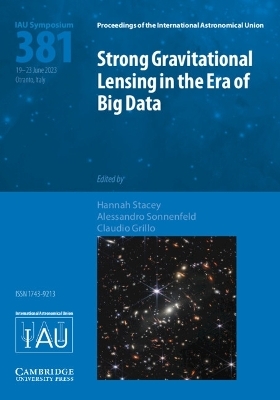
Strong Gravitational Lensing in the Era of Big Data (IAU S381)
Cambridge University Press (Verlag)
978-1-009-39899-2 (ISBN)
During recent decades, strong gravitational lensing has become a powerful tool to study astronomical objects with widely different physical scales. It has also proven to be a promising diagnostic that can solve outstanding problems in cosmology. Now is a critical time for strong lensing research, as forthcoming large surveys (Euclid, Roman Space Telescope, Rubin Observatory and CSST) will map the entire sky and increase the number of known lenses from a few hundred to around 100,000. Concurrently, observations of lenses with current and forthcoming instruments (ALMA, JWST, E-ELT) will spatially resolve scales that are beyond the reach of telescopes for objects in the distant Universe. These new data will revolutionise our understanding of galaxy and structure formation, and offer unprecedented cosmological applications. In IAU Symposium 381, members of observational and theoretical communities review our preparedness for this new era, to discuss advanced statistical techniques, and to foster new collaborations.
1. Strong lensing by galaxies: past highlights, current status, and future prospects Anowar Shajib; 2. The 'external' shears in strong lens models James Nightingale; 3. Strong lensing by edge-on galaxies in UNIONS Javier Alejandro Acevedo Barroso; 4. Joint lensing–dynamics constraint on the elliptical galaxy mass profile from the largest galaxy–galaxy lens sample Chin Yi Tan; 5. Strong lens detection 2.0: machine learning and transformer models Hareesh Thuruthipilly; 6. The last stand before Rubin: semi-automated inverse modelling of galaxy-galaxy strong lensing systems João Paulo França; 7. Lens discovery in the era of wide-area surveys Philip Holloway; 8. Gravitational lenses in hydrodynamical simulations Giulia Despali; 9. Lensed radio arcs at milli-arcsecond resolution: methods, science results, and current status Devon Powell;10. Clumpiness of lens galaxies as a window on dark matter Dorota Bayer; 11. Angular structure and gravitational imaging Conor O'Riordan; 12. Effectively investigating dark matter microphysics with strong gravitational lensing anisotropies Birendra Dhanasingham; 13. High-precision strong lensing models of galaxy clusters in the JWST era Pietro Bergamini; 14. Combined strong and weak gravitational lensing mass measurements in clusters of galaxies Davide Abriola; 15. Simulating high-realistic galaxy scale strong lensing in galaxy clusters to train deep learning methods Giuseppe Angora; 16. Shapes and centroids of 39 strong lensing galaxy clusters from the Sloan Giant Arcs Survey Raven Gassis; 17. MAximum-entropy ReconStruction (MARS): a new strong-lensing reconstruction algorithm for the JWST era Sangjun Cha; 18. The present & future of lensed supernovae: from ZTF to LSST Nikki Arendse; 19. Extended surface brightness modeling of three sources strongly lensed by an ultra-massive elliptical galaxy Andrea Bolamperti; 20. Large data set of lensed quasars: higher accuracy on H0? The angular structures viewpoint Lyne Van de Vyvere; 21. Accounting for population-level systematic effects using a hierarchical strategy Matthew R. Gomer; 22. Time delay cosmography of SDSSJ1433 with the 2.1m Wendelstein Telescope Giacomo Queirolo; 23. Impact of galaxy dynamics on Modified Gravity constraints from strong lensing systems Grasiele Romanzini-Bezerra; 24. Learning about the structure of strongly lensed AGNs from their lightcurves Dominique Sluse; 25. Where are the Eddington-limited starbursts? Gravitational lensing provides a way forward for sub-kiloparsec views of star formation Patrick Kamieneski; 26. Stellar mass fraction and quasar accretion disk size in SDSS J1004+4112 from photometric follow-up Raquel Forés-Toribio; 27. Probing the structure of SDSS J1004+4112 through microlensing analysis of spectroscopic data Carina Fian.
| Erscheinungsdatum | 03.05.2024 |
|---|---|
| Reihe/Serie | Proceedings of the International Astronomical Union Symposia and Colloquia |
| Zusatzinfo | Worked examples or Exercises |
| Verlagsort | Cambridge |
| Sprache | englisch |
| Maße | 180 x 254 mm |
| Gewicht | 460 g |
| Themenwelt | Informatik ► Theorie / Studium ► Künstliche Intelligenz / Robotik |
| Naturwissenschaften ► Physik / Astronomie ► Astronomie / Astrophysik | |
| ISBN-10 | 1-009-39899-7 / 1009398997 |
| ISBN-13 | 978-1-009-39899-2 / 9781009398992 |
| Zustand | Neuware |
| Informationen gemäß Produktsicherheitsverordnung (GPSR) | |
| Haben Sie eine Frage zum Produkt? |
aus dem Bereich


